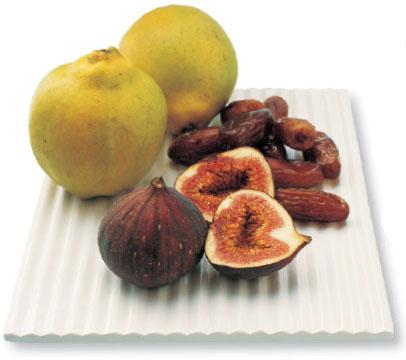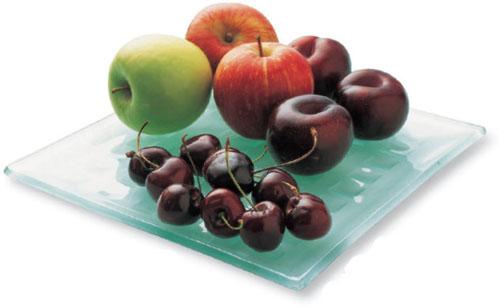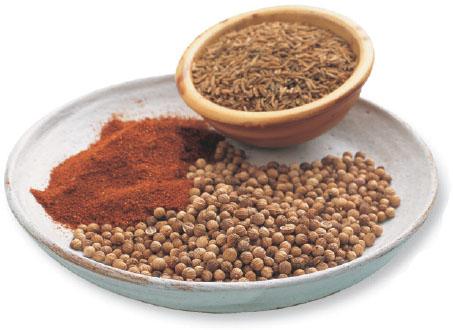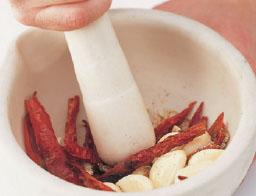Kosher and Traditional Jewish Cooking: Authentic Recipes From a Classic Culinary Heritage: 130 Delicious Dishes Shown in 220 Stunning Photographs (43 page)
Authors: Marlena Spieler

and
seeds
Fruit has always been important to the Jewish table. The first fruits of every season are the subject of specific blessings, with special affection being reserved for melons, figs, dates and grapes, because of their prominent place in the Bible. Nuts and seeds are also widely eaten, providing protein and variety to many dishes.
All fresh fruits are considered kosher and, for some very strict Jews, it is the only food they will eat if they are not sure of the Kashrut of a kitchen. Fresh fruit can be eaten whole, uncut by
treyf
(not kosher) knives.
Israel is one of the world’s leading fruit growers. Jaffa oranges, juicy grapefruit, kumquats and tiny lime- and lemonquats are grown for local consumption and export, alongside persimmons (Sharon fruit) from the Sharon valley and delicious avocados.

Quinces, dates and figs are among the warm weather fruits of the Sephardi table.

Apples, plums and cherries are fruits of the Ashkenazi table.
At Sukkot a lulav (citron) is used for making the blessings over the Sukkah. At Rosh Hashanah, apples are dipped in honey, pomegranates are eaten to celebrate fertility and abundance, quinces are baked and preserved and challah often contains dried fruit.
Ashkenazim make charoset, the fruit and nut paste enjoyed at Pesach, from apples and walnuts, while Sephardim favour tropical fruits and dried fruits. At Tu b’Shevat, Jews taste their way through a variety of orchard fruit, and at Chanukkah, apple sauce is served with potato latkes.
Sephardim, living in lush, warm climates, have always enjoyed a wide variety of fruits including figs, dates, melons and citrus fruits. Quinces are traditionally made into sweet preserves for Rosh Hashanah, stuffed for Sukkot, candied for Pesach, and added to meat stews at other times. Another speciality of the Sephardi Jews, particularly those from North Africa, are preserved lemons that have been pickled in brine. They are also often added to savoury dishes such as spicy meat stews.
Fruit was not as easily available to the Ashkenazim and soft and deciduous fruits were a seasonal delight for them. Raspberries, gooseberries, currants, cherries, plums, pears and apples were enjoyed in many dishes from pancakes and pastries to fruit soups, cakes and compotes. Baked apples filled with brown sugar and cinnamon are one of the classics of the Ashkenazi kitchen.
Surplus harvest was often dried or preserved and enjoyed during the rest of the year when the fruits were out of season. Compotes made of dried fruit are still very popular in the Ashkenazi kitchen.
Dried fruit is also often used in cakes and strudels as well as added to many meat dishes. Raisins are frequently added to meatballs and pie fillings, and the classic tzimmes (a savoury meat or vegetable stew) is enriched with the addition of dried apricots and prunes.
Classic Ashkenazi fruit soup makes a refreshing start or end to a meal. Plums, cherries or red berries give a good result, but any fruit can be used.
1
Chop 1.3kg/3lb fruit and place in a large non-reactive pan. Add 1 litre/1
3
/
4
pints/4 cups water, 475ml/16fl oz/2 cups dry white or red wine and the juice of 1 lemon. Stir in a little sugar, honey and cinnamon. Bring to the boil, then leave to simmer until the fruit is tender.
2
Mix 10ml/2 tsp arrowroot with 15ml/1 tbsp cold water. Stir into the soup, then bring to the boil and cook, stirring, until thickened.
3
Remove from the heat, stir in a little more water or wine if the soup seems too thick, then stir in a dash of vanilla extract. If using peaches, cherries or apricots, add almond extract instead. Allow to cool, then chill. Serve with sour cream or yogurt.
These are pareve and enjoyed by both Ashkenazim and Sephardim. They may be added to sweet or savoury dishes as an ingredient or eaten on their own as a snack. Street stalls in Israeli cities sell toasted nuts and seeds, known as garinim, for nibbling.
Almonds are used in sweet and savoury dishes. Mandelbrot (hard almond cookies) are among the classic sweets of the Ashkenazi kitchen, whereas almond paste is a favourite filling used in the filo pastries of North Africa and Mediterranean countries.
Pistachio nuts are enjoyed throughout the Middle East. Toasted and salted, they are a favourite snack. Unsalted pistachio nuts are crushed and layered into sweet desserts such as baklava, cake fillings and cookies.
Poppy seeds are particularly popular with the Ashkenazim. They are eaten in cakes such as the classic Russian mohn torte and sprinkled on top of breads such as bagels. Their flavour is intensified when they are roasted and ground to a paste, to be used as a filling for cakes and pastries.
Sesame seeds can be purchased whole or hulled, raw or toasted. For optimum flavour, buy raw hulled seeds. Just before use, toast them in a heavy, ungreased pan until fragrant and golden. Toasted sesame seeds can be crushed to make halva or tahini, or simmered with honey or sugar to make sumsum, crisp confections that are sold as street food in Israel. Walnuts are widely used in Ashkenazi cooking and are an essential ingredient in charosset, a paste of nuts, spices, wine and fruit representing the mortar the Jews used to build the pyramids, traditionally eaten at Pesach.

Almonds, sesame seeds and poppy seeds are widely used in traditional Jewish cooking
The sweet aroma of baked apples welcomes visitors to the deli. Fruit compotes and jellies, and rice puddings studded with dried fruit are all available. Apricot leather – a paste of cooked apricots, dried in sheets or strips, and eaten as a confection or warmed with boiling water until it reverts to a thick paste – is also a deli speciality. Dates are coated with coconut or stuffed with nuts and sold in blocks. Delis with a large Middle Eastern clientele have jars of sweet preserves, ready to be spooned out and eaten with plain cake. Green walnuts, cherries, plums and kumquats are all stewed in honey and sold in this way.
and
flavourings
The Ashkenazim used the flavourings of Eastern Europe to create their robust and often piquant dishes, while the Sephardim used their own local flavourings to create a cuisine that is richly spiced and aromatic.
A special place is reserved for herbs and spices in the rituals of the Jewish table. Both mild and bitter herbs are eaten at Pesach, while the sweet aroma of cinnamon, ginger, nutmeg and cloves is inhaled as part of the havdalah ceremony that signifies the end of Shabbat, the smell of the spices welcoming the week ahead.

Cumin and coriander seeds are favoured in the North African kitchen, while paprika is essential in Hungarian Jewish cooking.
Ashkenazim adopted the flavours of Eastern European cooking: young dill fronds, parsley, spring onions (scallions) and tender young garlic. Spices were also added to cakes and breads and occasionally meat dishes. A mixture of herbs and spices was used in pickled vegetables, meats and fish, contributing to their piquant flavours.
Countries with a strong German and Russian heritage introduced Jewish settlers to mustards of various kinds. In delis today you will find a large selection of mustards, such as wholegrain, smooth, sweet and herbed, ready to add their flavour to all manner of Ashkenazi dishes.
In Hungary, Ashkenazi Jews encountered paprika, and soon embraced it, making their own versions of dishes dominated by this warm, yet subtle, spice, such as chicken paprikash and the classic meat goulash.
In the same eclectic fashion, Jewish people embraced other flavours typical of all the different lands in which they lived: thyme and oregano from the Mediterranean region; cumin and coriander from India; cinnamon and harissa from North Africa and chillies from Mexico.
On the wondrous palette of Middle Eastern cooking, spice mixtures are the culinary colours. They add fragrance and flavour to whatever they touch. Middle Eastern spice blends are many and varied and may be dry ground mixtures or wet pastes made with fresh chillies, garlic and herbs. Spice blends taste much more intense if they are made from freshly roasted and ground spices.
This hot, spicy paste is used extensively in Tunisian and other North African cooking. It is based on medium-sized chillies with a medium hot flavour. The blend is widely sold in jars, but it is easy to make your own.
1
Put 10–15 whole dried chillies in a pan with enough water to cover. Bring to the boil, then remove from the heat.
